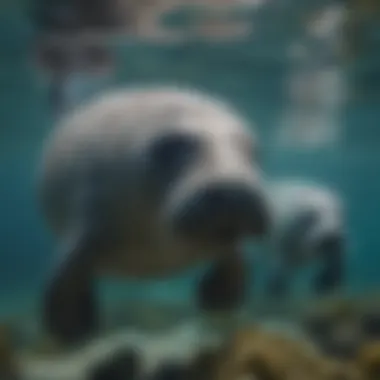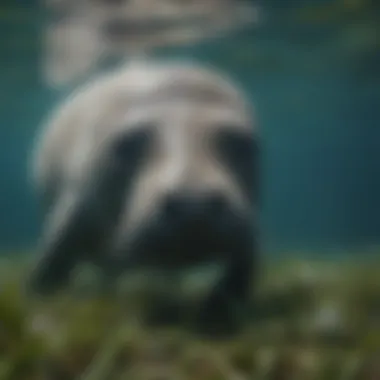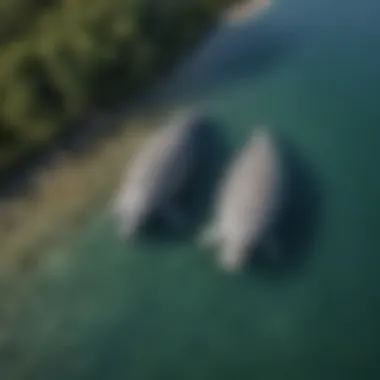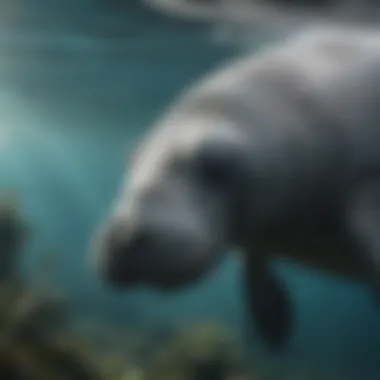Understanding Manatees and Their Predation Risks


Nature Topic Overview
Manatees, often known as sea cows, glide gracefully through the waters of rivers, estuaries, and coastal areas. Their gentle demeanor and distinct appearance make them a beloved species, but their existence in the aquatic ecosystem is more complex than it appears. Understanding manatees involves delving into their role in the environment, the challenge of predation, and how various factors affect their survival.
While manatees may not be considered top-tier predators, they still face threats from certain species, including sharks and crocodiles, which may occasionally prey on them. Additionally, human activities pose significant challenges that impact their habitats and overall well-being. To thoroughly comprehend the dynamics of manatee predation, it's critical to explore their habitats, known threats, and the interplay of conservation efforts.
Fun Facts and Trivia
- Did you know that manatees can hold their breath underwater for up to 20 minutes while they are resting? They usually come to the surface to breathe every 3 to 5 minutes while feeding or swimming.
- These aquatic giants can weigh as much as 1,300 pounds and are usually about 10 to 12 feet long!
- Despite their size, manatees are herbivores and primarily feed on seagrasses, algae, and other aquatic plants.
Visuals and Interactive Elements
To enhance learning, how about drawing a manatee? Kids can color in pictures of manatees and their habitats, sparking imagination and interest in conservation.
Wildlife Explorations
Manatees share their habitats with a variety of other species. Some interesting companions in their underwater environments include:
- Dugongs: Similar in appearance to manatees, dugongs are also herbivores and are often found in warm waters.
- Loggerhead Turtles: These turtles inhabit the same coastal areas and are often spotted swimming alongside manatees.
Quizzes can be a fun way to learn more about these creatures! For example, "What do manatees eat?" or, "Where do manatees live?"
Environmental Awareness
The importance of conservation efforts cannot be overstated when it comes to manatees. These gentle giants, often threatened by habitat loss and water pollution, highlight the need for sustainability. Here are some reasons why protecting manatees and their environment is essential:
- They play a crucial role in maintaining healthy underwater vegetation, which supports other marine life.
- Conservation of manatees leads to healthier ecosystems, benefiting both wildlife and humans.
Tips for Kids
There are simple ways kids and families can help protect nature:
- Participate in Local Clean-ups: Lend a hand in cleaning up local waterways.
- Share Knowledge: Talk about manatees and their challenges with friends and family—raising awareness is powerful!
DIY Nature Activities
Kids can dive into nature with these hands-on activities:
- Create a Manatee Habitat Diorama: Using shoe boxes, you can make a mini habitat for manatees using clippings from magazines for seagrasses and other plants.
- Make Water-Themed Crafts: Simple crafts like creating sea animals from paper plates can be a fun project, using paint and craft paper.
- Explore Outdoors: Plan a family trip to a nearby river or coastal area where manatees are known to roam, and keep an eye out for these magnificent creatures.
"Every time you save a piece of nature, you’re also saving a piece of yourself."
By understanding manatees and the challenges they face, we can inspire young minds to care for the environment. The survival of manatees not only depends on their ability to evade predators, but also on our collective efforts to protect their habitats and ecosystems.
Prolusion to Manatees
Manatees, often lovingly referred to as sea cows, are gentle giants of aquatic ecosystems. Understanding their existence, behaviors, and the inherent challenges they face is essential, especially when discussing predation. These soft-natured creatures hold a crucial place in their environments, and their survival tells a broader story about biodiversity and the impact of human interaction.
In this section, we will delve into the basics of what manatees are, how they differ from one another, and why they matter to the balance of marine life. By shedding light on these topics, we aim to establish a foundation that prepares readers for a deeper exploration of the dangers that threaten manatees, including natural predators and anthropogenic impacts.
Defining Manatees
Manatees belong to the order Sirenia. These aquatic mammals are herbivorous, primarily feeding on seagrasses and other aquatic vegetation. Characterized by their large bodies, flippers, and paddle-like tails, they are well adapted to a life spent underwater. Typically reaching lengths of up to 13 feet, manatees are quite sizable. Their skin, often grayish in color, is thick and wrinkled, providing protection while offering a means of camouflage against predators in murky waters.
Diversity and Species
Manatees are not just one kind of creature; rather, they represent a diverse group with several distinct species. Three primary species warrant attention: the West Indian manatee, the Amazonian manatee, and the African manatee.


West Indian Manatee
The West Indian manatee is perhaps the most familiar type, common along the coasts of Florida, the Caribbean, and parts of the Gulf of Mexico. One of the key characteristics of the West Indian manatee is its relatively large size, which makes it distinct yet also vulnerable. Their friendly demeanor often leads them to interact with humans, making them a popular choice for wildlife tours, but it also increases their risk of boat collisions.
A unique feature of the West Indian manatee includes its capability to thrive in both saltwater and freshwater, a trait that broadens its habitat. However, this flexibility can also be a double-edged sword as urban development and rising pollution levels threaten its habitats across these diverse ecosystems.
Amazonian Manatee
The Amazonian manatee, on the other hand, is a freshwater-dwelling species found in the rivers and lakes of the Amazon basin. This species is smaller than its relatives, usually growing up to 10 feet in length, which helps it navigate tightly packed riverine environments. A crucial aspect of the Amazonian manatee is its specialized diet; it feeds mainly on softer aquatic grasses and plants, which are abundant in its natural habitat.
Uniquely adapted to murky waters, the Amazonian manatee also has a less conspicuous coloration, which aids in camouflage. However, this species is notably endangered, primarily due to deforestation and poaching. These factors underscore the importance of habitat conservation for their survival.
African Manatee
Lastly, we have the African manatee. Found in tropical and subtropical waters along the west coast of Africa, this species showcases a blend of the traits seen in its other relatives. Similar in size to the West Indian manatee, it makes use of coastal areas as well as rivers and lakes. What sets the African manatee apart is its adaptation to different water temperatures, allowing it to live in varying environments.
A distinctive feature of the African manatee is its stronger reliance on freshwater habitats compared to other species, making it particularly susceptible to changes in water quality and depth. Thus, understanding its ecological role sheds light on the broader topic of how manatees contribute to the ecosystem and what they need for thriving.
In summary, each species of manatee—be it the West Indian, Amazonian, or African—offers unique insights into the life and challenges of these fascinating marine mammals. Their diversity not only enriches our understanding of aquatic ecosystems but also highlights the pressing issues surrounding their conservation and protection against predation.
Habitat and Distribution
Understanding the habitat and distribution of manatees is crucial for comprehending their survival strategies and the challenges they face from predation. These gentle giants are not wanderers by nature, but rather creatures that have evolved to thrive in specific environments. Their distribution across various regions impacts their interactions with both natural predators and human activities, making it an essential topic.
Preferred Environments
Warm Coastal Areas
Warm coastal areas serve as prime habitats for manatees. These regions are characterized by shallow waters that are rich in seagrass, a vital food source for these herbivorous mammals. The warm temperatures of these habitats not only promote the growth of seagrass but also help manatees maintain their body heat. A key characteristic of warm coastal areas is their accessibility; manatees can easily navigate through mangroves, bays, and estuaries, which are full of nutrients.
However, the popularity of warm coastal areas as a habitat comes with drawbacks. These environments often become crowded with boats and human activities, increasing the risk of boat collisions—one of the significant threats to manatees. The unique feature of warm coastal areas that benefits manatees is their sheltered environments, which offer safety from stronger currents and predators.
Freshwater Systems
Freshwater systems are another vital habitat for manatees, particularly in regions where rivers and lakes are abundant. These bodies of water provide an alternate food source, including the various aquatic plants that grow in freshwater environments. One of the standout features of freshwater systems is their relative isolation compared to coastal areas; this can offer manatees a reprieve from some marine predators.
However, not all is rosy in freshwater habitats. These environments are often vulnerable to pollution and habitat destruction due to agricultural runoff and urban development. This pollution can alter the water quality, affecting plant growth and, in turn, the food supply for manatees. On the other hand, freshwater systems provide a unique but sometimes precarious haven that supports their survival and reproduction.
Geographical Presence
North America
In North America, particularly in the United States, manatees primarily inhabit the coastal waters of Florida. The warm Gulf of Mexico provides a suitable sanctuary filled with seagrass beds. North America's geographical feature is advantageous for manatees because they can migrate between freshwater rivers during colder months and warm coastal areas during warmer times. Despite these advantages, they face significant threats, such as habitat loss and human interference.
South America
The Amazonian manatee, primarily found in South America, thrives in the freshwater systems of the Amazon River. The rich biodiversity of the region supports various plant life that serves as food. The unique feature of South America’s waterways is their slow-moving currents, allowing manatees to conserve energy while navigating their environment. The challenge here, however, lies in the increasing deforestation and pollution affecting these waters, threatening the manatee's food resources.
West Africa
West Africa is home to the African manatee, which resides in both freshwater and coastal areas. This region’s unique blend of habitats highlights the adaptability of these animals. The geographical presence of manatees in West Africa allows them to exploit both environments, enabling flexibility in food sourcing. Yet, the threats here are paramount; overfishing and habitat degradation pose significant risks, compelling the population to adapt constantly.
"The survival of manatees across various geographical regions is a testament to their adaptability but also underscores the vulnerabilities they face due to human impact."
Understanding the habitats and geographical distribution of manatees gives insight into how these aquatic mammals navigate their world despite the lurking dangers of predation and environmental threats.
Manatees and Predation


Manatees are often seen as gentle giants of the sea, gracefully gliding through warm coastal waters and calm rivers. But like any creature in the wild, their existence is intertwined with the reality of predation. The discussion around manatees and predation reveals much more than just who or what might pose a threat to these herbivorous mammals. It sheds light on their role within the ecosystem, highlighting both natural and human influences that can alter their survival chances. Understanding this section's pivotal elements can help to paint a clearer picture of how manatees navigate their world and what researchers must consider when focusing on their conservation strategies.
Natural Predators
Natural predators present a real challenge to manatees, even though these massive creatures primarily have to look out for human-related threats. Let’s delve into specific predators that pose a threat.
Sharks
Sharks are renowned for their predatory prowess in the ocean. Among the various species, the bull shark is particularly notorious for venturing into brackish and freshwater systems where manatees might roam. A key characteristic of sharks is their incredible sense of smell, sometimes able to detect a solitary drop of blood from over a mile away. This makes them effective hunters, able to capitalize on any weaknesses in their prey.
The unique feature of sharks is their adaptability; they can thrive in numerous habitats, which means they're often lurking where manatees might be. While shark attacks on manatees are not the norm, they can occur, especially if a manatee is injured or vulnerable. In a sense, discussing sharks in this context highlights the broader food chain dynamics in coastal areas. Their role emphasizes that even well-adapted creatures like manatees aren't entirely at the top of the food chain.
Crocodiles
Crocodiles are another significant predator within the manatee's habitat, particularly the American crocodile. These ambush predators rely on stealth and strategy to catch unsuspecting prey. An important factor in their predation behavior is that they can remain motionless for long stretches, waiting for the opportune moment to strike.
Crocodiles are powerful and possess a jaw strength that far exceeds that of sharks or other predators. This unique feature makes them deadly in shallow waters where manatees often graze. Although interactions between crocodiles and manatees are not commonly observed, these situations can turn perilous, especially when young manatees are involved. Consequently, highlighting crocodiles adds a layer of complexity to the predator dynamics impacting manatees.
Orcas
Orcas, or killer whales, add an intriguing twist to the discussion of manatee predation. Known for their striking intelligence and complex social structure, orcas can be formidable hunters. They have been known to hunt in pods using strategic techniques that maximize their chances of capturing prey. Though they operate primarily in oceanic environments, their broad diet can occasionally lead them to manatee territories, mainly if other food sources are scarce.
A distinguishing feature of orcas is their vocal communication; they use sounds to coordinate hunting efforts, turning the hunt into a very social event. This is a contrast to the solitary predator behavior seen in both sharks and crocodiles. It showcases the variations in predator behavior and highlights that while manatees are primarily herbivorous, they do face potential threats from apex predators in their ecosystems.
Human Impact
Unfortunately, the most pressing threats to manatees come from human activities. Their interactions with humans often create circumstances detrimental to their survival and can lead to a much higher predation risk from natural enemies.
Boat Collisions
Boat collisions represent a significant cause of manatee injuries and fatalities. In areas where boating is popular, the risk increases dramatically. One key characteristic of boat collisions is that they often happen quickly and without warning, with little chance for manatees to evade approaching vessels.
What’s particularly alarming is the unique feature of the waterways where manatees reside; they often overlap with popular boating areas, leading to frequent encounters. Despite regulations aiming to protect them, enforcement can be lacking. This continues to be a serious concern for manatee communities.
Habitat Destruction
Habitat destruction is another severe issue for manatees, often due to coastal development and pollution. As natural areas are converted for residential or commercial use, manatees lose access to critical habitats like seagrass beds or sheltered estuaries.
The critical aspect of this destruction is that it limits the space for feeding and breeding. Manatees need large areas to thrive, and reduced habitats can lead to increased competition for food and a greater likelihood of encountering predators. The degradation of their environment is an unfortunate push towards a more precarious existence.
Pollution
Pollution in waterways directly impacts manatees’ health and habitats. Nutrient runoff can lead to harmful algal blooms, which degrade water quality and diminish food sources like seagrasses. A defining characteristic of pollution's impact is that it’s often subtle yet pervasive, creating a cumulative negative effect over time.
The unique correlation here is that while manatees are resilient, increased pollution creates stress and can make them more vulnerable to other predators. When manatees are weakened or ill due to environmental toxins, their chances of escaping from predators drop, creating a concerning dynamic we can’t ignore.
The struggle for manatees to navigate their aquatic lives is fraught with both natural and human-induced challenges.
By recognizing both natural predators and human impacts, we can grasp the multifaceted challenges facing manatees today. Overall, this understanding allows us to advocate for greater conservation efforts and protection measures geared towards preserving these gentle sea creatures.
Defense Mechanisms of Manatees
Understanding the defense mechanisms of manatees is crucial when discussing their existence and survival. In the aquatic world, even gentle giants like manatees must protect themselves from predators and external threats. This section explores how these animals navigate danger through behavioral traits and physical attributes that help them maintain a stable presence in their ecosystems.
Behavioral Adaptations
Swimming Patterns


Manatees exhibit unique swimming patterns that serve as vital defense mechanisms. Their large, paddle-like tails allow them to glide gracefully through water, providing the opportunity to evade potential threats. This swimming style is not just about moving, it's about strategy. By swimming in a more cautious manner near areas where predators may lurk, manatees can stay one step ahead.
Key characteristics of their swimming patterns include a tendency to meander through seagrass beds or areas of dense vegetation. This gives them an added layer of protection because it’s harder for their predators to spot them among the aquatic plants. Ultimately, such patterns help reduce the frequency of encounters with sharks and other potential threats, showing how their natural instincts can guide them in seeking safety. However, these swimming behaviors do not guarantee safety, especially in crowded or polluted waters.
Group Dynamics
Group dynamics play a significant role in how manatees defend themselves against predators. These creatures are known to form loose groups, especially during foraging or when in areas where threats are more likely to be present. The presence of multiple manatees in a group makes it harder for a predator to choose a single target, causing confusion and increasing the chances of escape.
One unique feature of this social behavior is seen during migration periods, where juvenile manatees tend to stick close to adults. This not only ensures safety in numbers but also provides younger manatees with learning opportunities about navigation and environmental dangers. Group dynamics can therefore offer a dual layer of protection, as social interaction fosters a stronger alertness to potential risks. However, in areas with human activities, additional dangers like boat traffic can threaten these social structures, complicating their defense strategies.
Physical Adaptations
Size and Strength
The size and strength of manatees are defining traits in their defense against predation. These mammals can weigh over a thousand pounds and grow to lengths of about 10 to 13 feet. Their sheer size often deters potential predators. When confronted with threats, there might be a level of confidence that comes from their muscular frame.
This physical stature allows them to push through thick vegetation and swim away from danger effectively. It’s a form of intrinsic protection, as even predators like sharks might think twice before attacking a creature of such significant bulk. However, being large also has its disadvantages; they can be slower compared to smaller, nimble fish, which can pose a risk when escape routes become limited or crowded.
Camouflage
Camouflage serves as another piece in the puzzle of manatee defense mechanisms. Manatees often blend into their surroundings, particularly in murky waters where plants and sediment are prevalent. Their skin takes on algae and other plant material, effectively rendering them less visible in their natural environments.
This unique feature helps manatees remain undetected from predators which naturally relies on sight. However, camouflage alone cannot always keep them safe. In areas where visibility is essential, such as crystal-clear waters, their defense diminishes against vigilant hunters. The effectiveness of camouflage ultimately varies depending on their habitat, making it both an asset and an area of concern.
"Even the sweetest nature's giants must have a cunning plan to survive the turbulent waters of existence."
By examining these various adaptations, one can appreciate how manatees have evolved to navigate their unique challenges in the wild. Understanding their defense mechanisms equips us not only with knowledge but also fosters a deeper respect for these peaceful marine inhabitants.
Finale: The Manatee's Place in the Ecosystem
The welfare of manatees plays a significant role in the health of marine ecosystems. Manatees, often called "sea cows," are not mere gentle giants floating through the waters; they are crucial components of the aquatic food web. Their munching habits support the growth of seagrasses by grazing. Healthy seagrass beds are not only vital for manatees but also serve as shelter and nursery grounds for many fish species. Thus, the manatee's survival strategies contribute to the stability of their environment.
Survival Strategies
Manatees have adapted to a life mainly free from natural predators. Their size and the slow, graceful way they navigate their world reinforce a level of safety. They employ several techniques to ensure their survival, primarily through their intelligence and social behaviors. Manatees are known for their social interactions, often forming loose groups.
- Vigilance: Manatees are semi-aware of their surroundings, often seen lifting their heads to observe potential threats. This behavior acts as a natural alarm system that keeps them alert against possible dangers.
- Strategic Migration: During colder months, manatees move towards warmer waters, resulting in a seasonal cycle of safety. This movement reduces their risks of cold stress and basic survival challenges.
These strategies, combined with their generally docile nature, indicate how vital they are for maintaining balance within their ecosystem.
Environmental Conservation Efforts
To safeguard the future of manatees, various conservation initiatives are underway. These efforts not only benefit manatees but also promote overall ecosystem health.
Protected Areas
Protected areas serve as safe havens for manatees, offering them a sanctuary where they can thrive without the fear of external threats. This concept revolves around the idea that certain vital habitats should be preserved in order to sustain species populations.
Key characteristics of protected areas include:
- Restrictions on Human Activity: Activities such as boating and fishing are limited to minimize human impact on the manatees’ habitats.
- Regulated Clean-up Efforts: Protected marine areas often have dedicated clean-up crews working to keep waterways free of pollutants and debris that could harm manatees.
The unique feature of these areas is the regulations that actively enforce conservation efforts, ultimately leading to a healthier marine ecosystem. The benefits are clear: these zones allow for the replenishing of not just manatee populations but also numerous other aquatic species. However, they require ongoing public support and funding to remain effective.
Community Awareness
Community awareness plays an essential role in the conservation of manatees. Educating people about the importance of these gentle creatures fosters respect and responsibility toward their habitats.
The emphasis on community involvement creates an environment where:
- Local Advocacy Flourishes: Groups often spring up to advocate for manatee protection. As the public becomes more aware, they can push for improved laws and practices that protect these animals.
- Sustainable Practices Increase: When people understand the connection between their actions and the health of manatees, they may embrace more environmentally friendly habits, such as reducing plastic use or boating cautiously in manatee habitats.
While community awareness has many benefits, it can be challenging to maintain high levels of engagement long-term. Ongoing education and involvement are required for this effort to thrive. However, the result is a more informed public ready to support local wildlife conservation initiatives.
In summary, manatees hold a vital position in their ecosystem. Protecting them is closely tied to promoting the health of their habitats and, subsequently, the overall marine environment. Focusing on sustainable practices and enhancing community understanding are critical to ensuring these remarkable creatures persist for generations to come.







